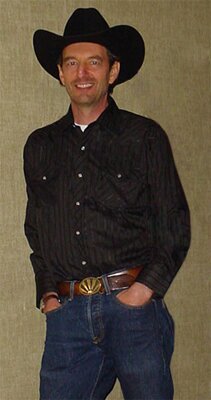Welcome to the “My Place” page
 My name is Scott My name is Scott
I run the Rope and Wire website.
My original idea for this page was to give those living in the country the opportunity to tell others about the things that made their farm or ranch so special.
Well, I’ve come to the conclusion that either no one likes to brag or no one lives on a farm or a ranch. Whatever the case, no one submitted an article so I felt it was high time to try something different.
So for now this will be literally “My Place.” I’ll use this page to post a western blog or short articles. They will either be mine, or possibly one from a contributing R&W community member.
The theme will remain Western but the content will change weekly, or there about.
If you click on any of the links to past blog's, you can return to this page by clicking on the My Place button across from my picture.
I hope you enjoy it but if not, might I suggest you “stroll the grounds.” Read a story or watch a movie.
Thanks for visiting.
Scott
The humble “Chuck Wagon”
How one mans idea revolutionized the cattle industry.
The civil war had ended and the country was on the mend. The West was opening up and cattle ranchers were moving cattle across the country from as far South as Texas to the railheads of Kansas and Missouri. From there they were dispersed as far North as Canada.
Before 1866 cattle drives offered no organized method of feeding and caring for the men who drove those cattle. Most were on their own when it came to feeding and caring for themselves. Their rations were very basic and often lean.
The year was 1866.
While preparing to drive two thousand head of cattle from Texas to Denver, a young man named Charles Goodnight came up with a very progressive idea. Instead of having his men fend for their meals themselves, he would organize a way to feed and care for them along the trail. This would not only keep up their physical strength and mental awareness, it would also free the men from the burden of carrying essential supplies and equipment.
Charles purchased a surplus military wagon and designed it to be a mobile kitchen.
He also hired a cook to prepare hot meals for his men.
The wagon was bowed on top and covered with waterproof canvas. It was about ten feet in length and a little more than three feet wide. He filled it with the supplies and equipment they would need along the trail. The back of the wagon was fitted with a box. It was well supplied with an assortment of food and cooking utensils that would be needed for the long trail drive. The lid was hinged at the bottom and doubled as the cooks work table when it was opened.
A barrel hooked to the side of the wagon carried a two-day supply of water.
A cowhide cradle under the wagon carried the fuel supply gathered by the cook as he drove on ahead of the herd.
The cook was expected to have a hot meal ready for the outfit when it arrived at a predetermined spot at the end of the day. He was also up several hours before the rest of the men preparing the morning meal. Most cooks doubled as a barber, a medic and sometimes a referee. The cook worked harder and slept less than any other man in the outfit. But he was paid well for his trouble. Sometimes double the wages of any of the other men.
The chuck wagon was a natural gathering place. Meals were served up at the wagon and eaten in the general area. As the sun went down cowboys would gather around the cooks fire and recount the experiences of the day, tell stories and enjoy each other’s company over a hot cup of coffee.
The cook usually went by the name of “cookie” but behind his back he was often known as the “bean wrangler”, “dough puncher” or “biscuit shooter.”
But even so, he was the most respected member of the outfit.
At the time, the concept of the chuck wagon was the single most important factor in the growth of the American cattle industry.
Its place in Western history is assured.
|